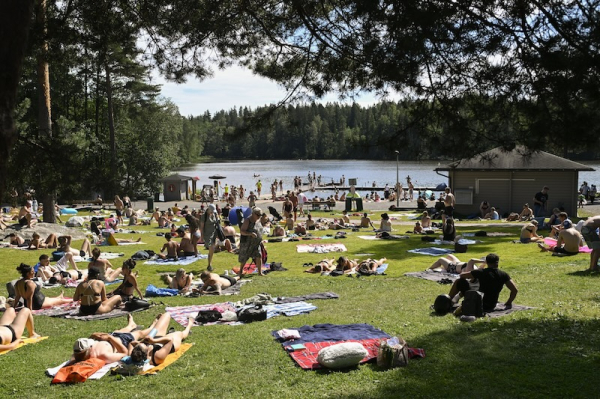Nordic heatwave made 10 times more likely by climate change, scientists say

Sunbathers at the Kuusijärvi beach in Vantaa on 20 July 2025. Photo: Mikko Stig / Lehtikuva
- Next Article Court blocks autumn bear hunt permits in eastern Finland
Climate change made the record-breaking July heatwave in Norway, Sweden and Finland ten times more likely and around 2°C hotter, according to a rapid study published on Wednesday.
The findings, released by the World Weather Attribution (WWA) group, confirm that even traditionally cold countries are now facing extreme summer temperatures with rising health, environmental and economic impacts.
Researchers said the mid-July heatwave would have been highly unlikely without global warming, and that similar events will become five times more frequent by the end of the century if global temperatures reach 2.6°C above pre-industrial levels.
Finland recorded 22 consecutive days over 30°C, the longest heatwave in its history. In Sweden, several locations reported ten consecutive tropical nights, with minimum temperatures staying above 20°C. In Norway’s Arctic region, temperatures reached over 30°C on 13 separate days.
Friederike Otto, lead author and climate scientist at Imperial College London, said the data clearly show that “no country is safe from climate change.”
Hospitals across the region were overcrowded and overheated, with some cancelling planned operations. At least 60 people drowned as more sought relief from the heat in lakes and coastal waters. Forest fires broke out in multiple areas, while toxic algal blooms spread across bodies of water.
In some towns, reindeer were seen gathering in shaded car parks and under bridges. Herders warned that the animals were unable to graze or cool down, threatening their survival.
The impact on reindeer has disrupted the traditional livelihoods of the Sámi people, Indigenous communities who have herded the animals for centuries.
“This is not just an environmental threat. It also affects the health, culture and rights of Indigenous people,” said Maja Vahlberg, a climate consultant at the Swedish Red Cross.
Vahlberg said she personally observed reindeer remaining in one patch of shade for three days without moving. “Our infrastructure was not designed for this kind of heat,” she said. “We are seeing hospitals, care homes and apartments struggling to stay safe.”
The researchers compared the current heatwave to the one in 2018, when around 750 excess deaths were recorded in Sweden over five weeks. Full mortality figures for the 2025 event are not yet available, but scientists expect similar levels.
“This was a silent killer,” said Clair Barnes, a climate researcher at Imperial College London. “The combination of relentless daytime temperatures and hot nights put enormous pressure on people, especially the elderly and those with chronic illness.”
In the Norwegian town of Karasjok, where July temperatures exceeded 30°C for multiple days, the local hospital reported a sharp increase in heat-related admissions.
Data from the Swedish Meteorological Institute showed a cluster of tropical nights in the country’s north, a phenomenon described as “extraordinary” by Erik Kjellström, professor at the institute.
Prolonged night-time heat is considered a high-risk factor by public health authorities, as it prevents the body from recovering after daytime exposure.
The researchers said every fraction of warming increases the likelihood of future heatwaves. The 0.2°C rise in global temperature since 2018 has already doubled the probability of a prolonged heat event in the region.
The study also warned that the wider ecological consequences are escalating. Wildfires, heat-stressed animals, and warming waters with low oxygen levels are threatening biodiversity in forest and freshwater ecosystems.
In Finnish Lapland, fire crews responded to multiple wildfires during the final week of July. Many areas, typically unaffected by summer blazes, reported ground-level fires triggered by dry moss and leaf litter.
The heatwave has intensified calls for governments in the Nordic region to improve infrastructure resilience, strengthen early warning systems, and accelerate the shift away from fossil fuels.
Otto said the Nordic heatwave is part of a broader pattern of climate extremes seen across the northern hemisphere this summer. She said the current level of warming, 1.3°C above pre-industrial averages, is already resulting in frequent, dangerous conditions.
In response to the study, meteorological agencies in Sweden, Norway and Finland reiterated their warnings about summer preparedness. Health officials in all three countries urged residents to check on elderly neighbours, avoid strenuous activity during peak hours and stay hydrated.
Scientists expect this type of heat event to occur roughly once every 50 years under current climate conditions. At 2.6°C of warming, similar two-week heatwaves are projected to occur every ten years, and with even higher peak temperatures.
The findings add to mounting evidence that northern Europe is no longer insulated from the impacts of climate change.
HT
- Next Article Court blocks autumn bear hunt permits in eastern Finland
Source: www.helsinkitimes.fi
